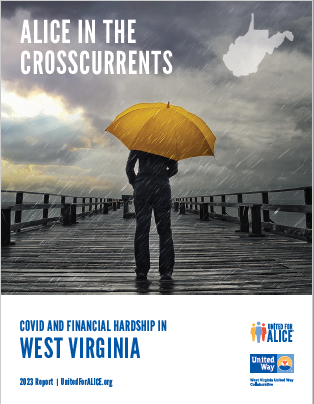
Meet ALICE
ALICE, an acronym for Asset Limited, Income Constrained, Employed, is a new way of defining and understanding the struggles of households that earn above the Federal Poverty Level, but not enough to afford a bare-bones household budget.
For far too many families, the cost of living outpaces what they earn. These households struggle to manage even their most basic needs - housing, food, transportation, child care, health care, and necessary technology.
When funds run short, cash-strapped households are forced to make impossible choices, such as deciding between quality child care or paying the rent, filling a prescription or fixing the car. These short-term decisions have long-term consequences not only for ALICE families, but for all of us.
Who is ALICE?
Despite the critical nature of many jobs to keep our local economies running – educating our youngest children, keeping our ailing parent safe – these workers often struggle to keep their own households from financial ruin.
ALICE is your child care worker, the cashier at your supermarket, the gas attendant, the salesperson at your big box store, your waitress, a home health aide, an office clerk. ALICE cannot always pay the bills, has little or nothing in savings, and is forced to make tough choices such as deciding between quality child care or paying the rent. One unexpected car repair or medical bill can push these financially strapped families over the edge.
ALICE is people of all ages, genders, races, and ethnicities, living in urban, suburban, and rural communities. However, some groups are disproportionately represented in hardship due to longstanding discrimination and systemic racism, sexism, ageism, and ableism.
The ALICE Report
This ALICE Report for West Virginia provides the most comprehensive look at the population called ALICE — households that have incomes above the Federal Poverty Level but that struggle to afford household necessities. This report provides high-quality, research-based information to foster a better understanding of who is struggling in our communities.
The ALICE Report for West Virginia presents the latest ALICE data available. By showing how many West Virginia households are struggling, the ALICE research provides the backstory to implement changes that improve the lives of ALICE. The ALICE data is especially important now to help stakeholders identify the most vulnerable in our communities, and direct programming and resources to assist them.
This Report highlights the financial struggles of West Virginia’s low-income workers and families. The ALICE measures help stakeholders ask the right questions, reduce vulnerabilities, remove obstacles to advancement, identify gaps in community resources, build a stronger workforce, and implement programs and policies that help put financial stability within reach for ALICE households and create equity across communities.
Read the Report
ALICE in the Eastern Panhandle Profile
Explore the Data
CHILDREN IN FINANCIAL HARDSHIP
The number of children growing up in financial hardship in West Virginia has been systematically undercounted. For decades, policymakers and community stakeholders have relied on the outdated Federal Poverty Level (FPL) to understand the extent of financial hardship in their communities. According to the FPL, 19% of children in West Virginia (68,852) lived in poverty in 2019. Yet United For ALICE data shows that another 29% (104,468) were also growing up in hardship, in households that earned above the FPL but not enough to afford the basics in the communities where they lived.
The reality is that 173,320 children in West Virginia — 48% of all children — lived in a household with income below the ALICE Threshold of Financial Survival in 2019. These households included families in poverty as well as those who were ALICE: Asset Limited, Income Constrained, Employed. ALICE households don’t earn enough to afford the essentials of housing, child care, food, transportation, health care, a smartphone plan, and taxes — the basics needed to live and work in the modern economy.
More data is available through the ALICE in Focus: Children interactive data dashboard – which provides filters for regional and local geographies, age, race, disability status, living arrangements and household work status.
Click here to view the West Virginia State Research Brief.
DATA FOR ACTION
 United Way of the Eastern Panhandle is leading conversations and coalitions to both raise awareness and take action to address the growing ranks of ALICE households in West Virginia. We’re working to lift the economic well-being of ALICE and all residents.
United Way of the Eastern Panhandle is leading conversations and coalitions to both raise awareness and take action to address the growing ranks of ALICE households in West Virginia. We’re working to lift the economic well-being of ALICE and all residents.
Stakeholders across all sectors can use the ALICE data to help identify gaps by town, ZIP code, and county. This is especially crucial as the COVID-19 recovery will require renewed efforts to provide ALICE households with access to employment, affordable child care, access to healthy food, quality health care, and stable housing.
The ALICE data can also be used to keep history from repeating itself. Households one income bracket above the ALICE Threshold fell into financial hardship following the Recession, expanding the ranks of ALICE households. If the same were to happen post-pandemic, the nearly 41,000 West Virginia households who were just above the Threshold in 2019 could become ALICE, bringing the number of struggling households up from 45% to 51%.
Unlike the one-size-fits-all model of the Federal Poverty Level, which assigns a uniform poverty measurement across the country, the ALICE data is a real-time examination of what it takes to survive at the local level. Using all publicly sourced data, United For ALICE presents the actual costs of a Household Survival Budget at the county level and how many households earn below that amount. The budget consists of the most conservative cost options for housing, child care, food, transportation, health care, and a basic smartphone plan.
Contact us for ALICE presentation opportunities, to learn about current programs serving ALICE, and start discussions on how to identify solutions to help move ALICE toward financial stability.

